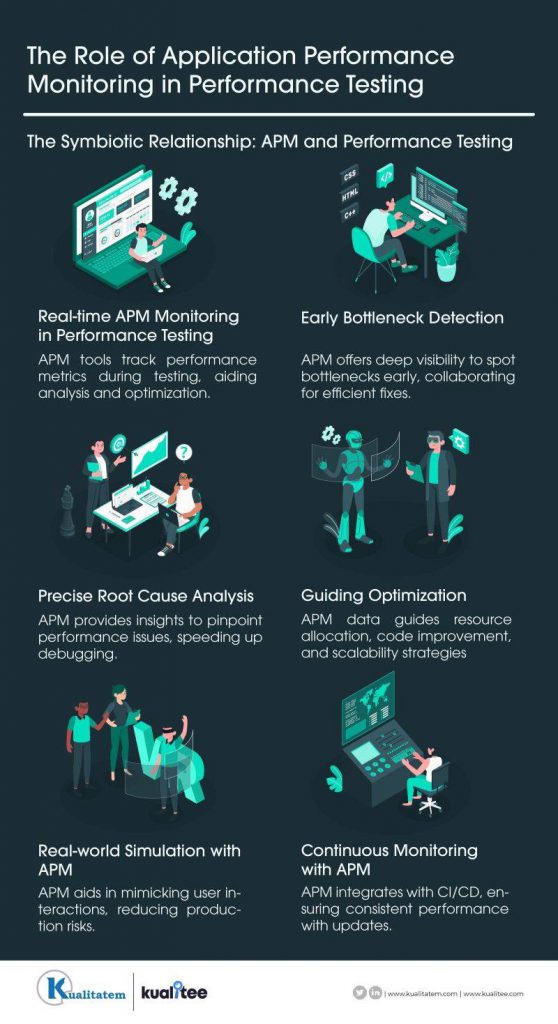The Role of Application Performance Monitoring in Performance Testing

- August 16, 2023
- admin
The demand for high-performing applications has remained unchanged in the dynamic software development landscape. This places a significant responsibility on Performance Test Engineers to ensure that applications can handle varying loads, deliver seamless experiences, and maintain responsiveness through various performance testing services. Among the array of tools available, Application Performance Monitoring (APM) emerges as an essential component in the arsenal of performance testers.
This blog explores APM’s multifaceted role in enhancing performance testing’s efficiency and effectiveness.
Understanding Application Performance Monitoring (APM)
Before delving into the role of APM in performance testing, let’s establish a solid understanding of what APM entails. APM encompasses a suite of practices, methodologies, and tools designed to monitor and manage the performance of applications. It provides insights into critical metrics related to response times, transaction rates, resource utilization, and more. By doing so, APM empowers Performance Test Engineers to gain real-time visibility into application behavior and detect performance bottlenecks promptly.
The Symbiotic Relationship: APM and Performance Testing
Performance testing and APM are interwoven in a symbiotic relationship that contributes to the success of software projects. Let’s explore the various facets of this relationship:
Real-time Monitoring for Timely Insights in Performance Testing
The real-time monitoring capabilities of APM are particularly advantageous during performance testing. As load is applied to the application, APM tools gather data on performance metrics. Performance Test Engineers can analyze this data in real-time, identifying deviations from expected behavior and potential bottlenecks. With this timely insight, testers can adjust test parameters, simulate different load scenarios, and make informed decisions that contribute to optimizing application performance.
Early Detection of Performance Bottlenecks
Performance bottlenecks can arise from various sources, such as database queries, network latency, or inefficient code. APM tools aid Performance Test Engineers in the early detection of these bottlenecks by providing deep visibility into application components and their interactions. By identifying bottlenecks early, testers can collaborate with development teams to address underlying issues, ultimately preventing performance degradation in production environments.
Precise Root Cause Analysis
Determining the root cause of performance issues is crucial for effective resolution. APM tools offer comprehensive insights into application behavior, including transaction paths, code traces, and system dependencies. With this information, Performance Test Engineers can isolate the components responsible for performance degradation. This precision expedites the debugging process and facilitates targeted fixes.
Guiding Performance Optimization Efforts
APM data goes beyond issue identification—it provides valuable insights for optimizing application performance. Performance Test Engineers can analyze APM metrics to identify trends and patterns that highlight areas for improvement. These insights guide resource allocation, code optimization, and scalability strategies. By basing optimization efforts on real-world usage patterns, testers can ensure that revisions have a tangible impact on the user experience.
Simulating Real-world Scenarios with APM in Performance Testing
Performance testing aims to mimic real-world conditions to uncover potential issues. APM tools enhance this endeavor by enabling testers to simulate user interactions and behaviors using the gathered data. By replicating realistic load profiles, Performance Test Engineers can validate the application’s performance under varying conditions. This practice ensures that the application’s interpretation aligns with user expectations and minimizes the risk of unexpected issues in production.
Enabling Continuous Performance Monitoring
The paradigm of continuous integration and continuous delivery (CI/CD) demands continuous performance monitoring. APM seamlessly integrates with this approach, enabling application performance monitoring as new features and updates are rolled out. Performance Test Engineers can leverage APM’s real-time insights to assess the impact of changes on application performance immediately. This proactive approach helps maintain consistent performance levels and prevents regression.
Conclusion
In the intricate tapestry of performance testing, Application Performance Monitoring emerges as a pivotal thread that weaves various aspects of the testing process. Its real-time monitoring capabilities, early bottleneck detection, root cause analysis, optimization guidance, support for realistic simulations, and alignment with continuous monitoring practices make it indispensable for Performance Test Engineers.
As the software landscape evolves and user expectations continue to rise, integrating APM becomes imperative for ensuring that applications function and deliver exceptional user experiences. By harnessing the power of APM, performance testers are poised to navigate the complexities of modern application performance testing with confidence and proficiency.












